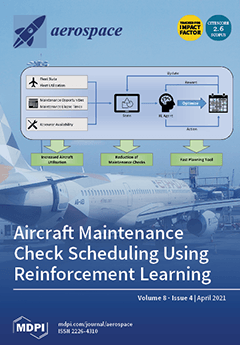Successful icing/de-icing simulations for rotorcraft require a good prediction of the convective heat transfer on the blade’s surface. Rotorcraft icing is an unwanted phenomenon that is known to cause flight cancelations, loss of rotor performance and severe vibrations that may have disastrous and deadly consequences. Following a series of experiments carried out at the Anti-icing Materials International Laboratory (AMIL), this paper provides heat transfer measurements on heated rotor blades, under both the anti-icing and de-icing modes in terms of the Nusselt Number (
Nu). The objective is to develop correlations for the
Nu in the presence of (1) an ice layer on the blades (
NuIce) and (2) liquid water content (
LWC) in the freestream with no ice (
NuWet). For the sake of comparison, the
NuWet and the
NuIce are compared to heat transfer values in dry runs (
NuDry). Measurements are reported on the nose of the blade-leading edge, for three rotor speeds (
Ω) = 500, 900 and 1000 RPM; a pitch angle (
θ) = 6°; and three different radial positions (
r/R),
r/R = 0.6, 0.75 and 0.95. The de-icing tests are performed twice, once for a glaze ice accretion and another time for rime ice. Results indicate that the
NuDry and the
NuWet directly increased with
V∝,
r/R or
Ω, mainly due to an increase in the Reynolds number (
Re). Measurements indicate that the
NuWet to
NuDry ratio was always larger than 1 as a direct result of the water spray addition.
NuIce behavior was different and was largely affected by the ice thickness (
tice) on the blade. However, the ice acted as insulation on the blade surface and the
NuIce to
NuDry ratio was always less than 1, thus minimizing the effect of convection. Four correlations are then proposed for the
NuDry, the
NuWet and the
NuIce, with an average error between 3.61% and 12.41%. The
NuDry correlation satisfies what is expected from heat transfer near the leading edge of an airfoil, where the
NuDry correlates well with
Re0.52.
Full article





